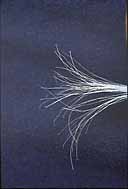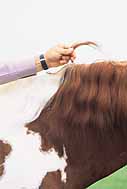DNA Typing & Parentage Verification
Parentage verification by DNA testing provides confirmation a foal is the offspring of the parents listed on the registration papers. It is required for all registrations submitted to APHA as of January 1, 2022. Prior to that, it was required for certain breeding methods and racehorses.
What is DNA?
DNA contains the genetic code that dictates a horse’s physical appearance. Microsatellite markers are the basis for individual identification useful in parentage verification. They are amplified and measured by gel electrophoresis and computer analysis.
When does APHA require testing?
The following instances require DNA testing:
- All stallions used for breeding must have a DNA type on file before any offspring can be registered. As of January 1, 2017, all stallions must have DNA Genetic Health Panel results (HYPP, HERDA, GBED, MH, PSSM1, OLWS) on file before the foals resulting from their 2018 breedings will be eligible for registration.
- Racehorses are required to be parentage verified prior to being tattooed.
- Beginning January 1, 2022, all registrations require parentage verification. That is regardless of breeding method or horse age.
- DNA testing for Paint pattern genes can help a Paint Horse earn Regular Registry classification.
- See current Rule Book for full details.
The “How to”
A DNA testing kit can be ordered from PHcentral.com if the horse is already registered—options there includes UC-Davis testing for genetic typing, genetic health conditions and Paint colors/patterns. Testing for color/pattern/health conditions can be ordered from Etalon Diagnostics’ website (select the APHA Complete Panel); be aware, that does not include DNA genetic typing testing. A DNA order form is also available at apha.com/forms/registration-forms. Once processed, the DNA kit will be emailed to you.
If you want to test a foal that is not yet registered, you must first apply for registration and check the appropriate box on the registration application requesting the DNA kit. The MemberCare Department will enter the needed information, and then issue the DNA kit. Please keep in mind that turn-around times for new registrations vary throughout the year, so the issuing of your DNA kit may also be delayed.
When you receive your DNA kit in the mail, it is essential to verify that the information on the DNA kit matches the horse you are testing. A registered horse’s name and number will appear on the kit. A foal that is pending registration will receive a UR (unregistered) number for laboratory tracking purposes and will also list the color, type, sex, year foaled, sire and dam. When testing multiple horses at the same time, it is essential to finish one horse before moving on to the next horse to avoid mistakes. Many parentage exclusions at the laboratory are caused by these errors and additional re-test fees may apply.
In obtaining hair samples, mane hair is recommended unless you are testing a foal under 6 months old, which requires tail hair. Mane hair from a young horse is very fine, causing the roots to break off. When tail hair is sampled, the short hair near the base of the tail is best and easiest to obtain. Simply grasp the hairs near the bottom and give a swift pull. It’s best to try to get the entire sample at once. This procedure causes very little stress to the horse.
Again, make sure the roots are attached. Roots resemble a small bulb and are visible with the naked eye or magnifying glass. Long hair can be trimmed on the non-root end only.
The turn-around time at the laboratory is approximately 2 weeks if everything is correct. Insufficient hair samples will require a new sample, thus delaying the process. When the testing is complete, the laboratory will forward the results electronically to APHA.
What about testing for HYPP, overo lethal white, etc?
APHA offers genetic health and coat color testing in addition to DNA testing. The Genetic Health Panel testing includes evaluation for HYPP, HERDA, GBED, MH, PSSM1 and OLWS. Color and pattern tests—available individually or as part of a panel test—include red factor, agouti, cream, pearl, champagne, dun, silver, gray, Tobiano, Frame Overo, Splash White, Sabino 1 and Dominant White. Comprehensive packages are available at discounted rates when multiple tests are requested. Learn More.
The testing procedures are simple, can add value to the horse, and give you peace-of-mind in knowing the parentage of your horse is more than just” true and correct to the best of your knowledge.”







